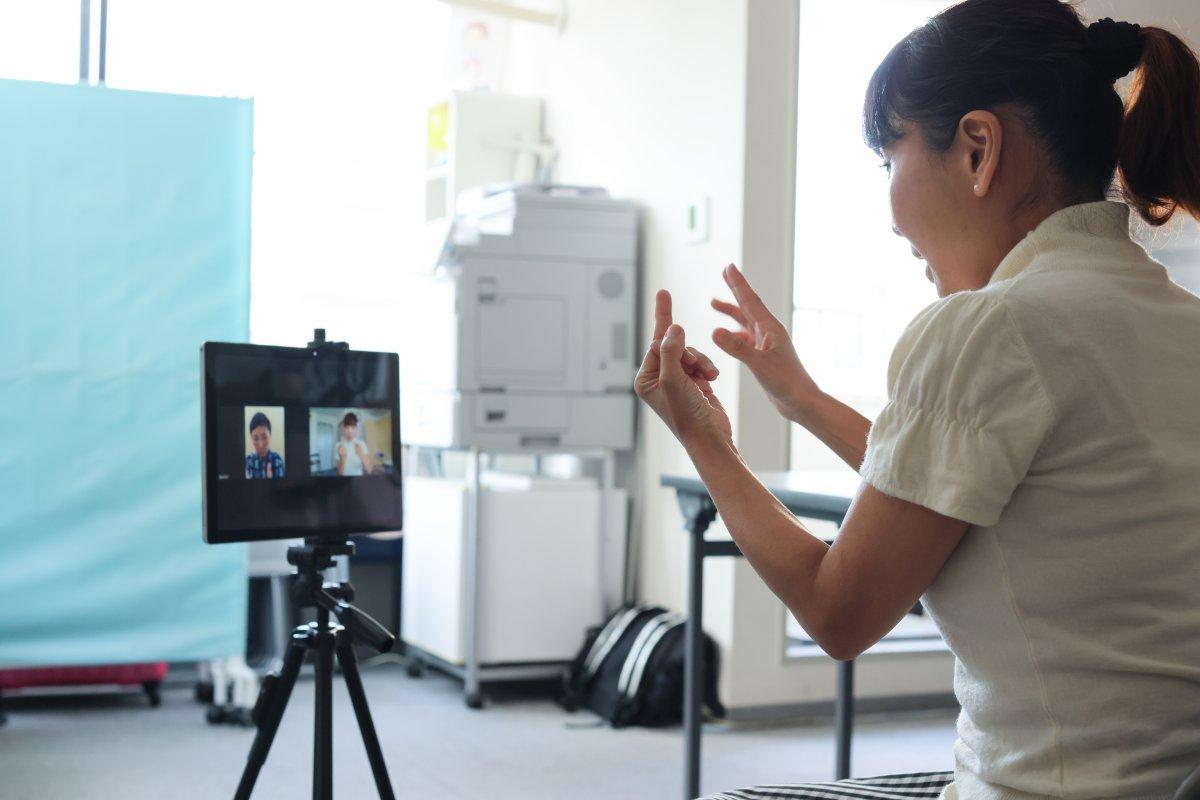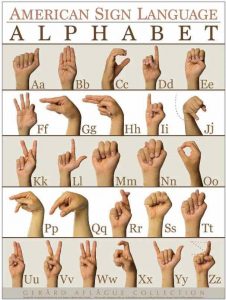If you’re reading this, you’re probably interested in learning the alphabet in sign language. Maybe you have a Deaf family member or saw a sign language interpreter at a performance; no matter the reason, you’ve come to the right place to start your journey. You might be wondering how difficult it is to learn American Sign Language and how to begin.
Learning a new language or form of communication can seem intimidating, but learning American Sign Language (ASL) is something anyone can do. Whether you’re signing for the first time or want to brush up on your skills, mastering ASL letters is a great place to start.
In this post, we’ll give you some tips on how to master American Sign Language alphabet individual letters so you can start communicating in no time!
How Many Letters Are in American Sign Language?
Just like American English, American Sign Language has 26 different letters to use to communicate. Here are a few other facts:
- American Sign Language (ASL) uses handshapes and gestures to communicate.
- There are over 3000 signs in ASL that each represent a different letter, number, or meaning.
- Every sign is a combination of one of more than 20 handshapes, locations on the body where the sign is made, and movements of the hands and body.
Are you ready to start taking American Sign Language? Sign up for lessons today, and learn more about the many benefits of doing so by watching the video below:
https://www.youtube.com/watch?v=v1desDduz5M
What is the Alphabet in American Sign Language?
So what is the American Sign Language letters alphabet?
A great place to start when learning any language is with letters and numbers, right? As a baby, you probably learned the 26 letters in the English alphabet and numbers 1-10 first, followed closely by colors and animals. With that in mind, let’s begin with the letters. The ASL alphabet, like the English alphabet, includes 26 unique, manual handshapes.
Now is as good a time as any to make a few important points. ASL is not English or a visual code for English. ASL and English have different phonology and grammar. Further, ASL is not a universal language. Each country has their own sign language, developed by indigenous Deaf people. So keep in mind, even when visiting other English-speaking countries, such as Ireland or Australia, they do not use ASL. Their manual sign language letters will be different from the ASL alphabet. But let’s not get ahead of ourselves. Once you become fluent in ASL and plan to travel abroad, we can talk more about what to do when you encounter Deaf locals.
Learning letters in American Sign Language is a foundational step in learning this visual language. Using the letters in the ASL alphabet is called fingerspelling. Fingerspelling is often used for proper nouns (e.g., peoples’ names, movie titles, places, book titles) and specific kinds in a group (e.g., wheat, rye, etc. – the various types of bread). Forming the letters on your hands is similar to handwriting because it is unique to you, but has standards that everyone who knows the language has agreed upon and can understand. Just as with handwriting, it is vital to be clear in your fingerspelling if you want to be understood.
How to Learn the ASL Alphabet
Finding the American Sign Language alphabet in ASL online is simple using a quick Google search. There are some slight variations (especially with the letters f and n, so be sure to use a reputable version, if you can identify one, like the chart here by a i media:
Learn the Basic Letters in American Sign Language
The average person with no knowledge of ASL letters should start with the letters of the alphabet sign language. If you’re a beginner, here are some tips to help you succeed with fingerspelling:
- All letters are produced one-handed, using your dominant hand.
- Hold your dominant hand steady at about shoulder height, in front of the chest. Relax your arm and keep your elbow down, close to your side.
- Never fingerspell in front of your face. Your listener should be able to see both your face and your hand.
- Avoid bouncing when fingerspelling. The letters should flow continuously, rather than appear letter by letter.
- When fingerspelling, your dominant hand moves away from the body.
- Use the correct handshape, not approximations or variations. For example, the letter below is i. The first illustration is the correct handshape for the letter i. Notice the second illustration is an incorrect handshape due to the slight lean in the hand and the misplaced thumb.
correct incorrect
- In general, do not move your hand sideways like a typewriter when you form each letter of a word. There are some exceptions, such as double letters, but don’t worry about those exceptions in the beginning.
- Mistakes happen. If you make a mistake while fingerspelling, don’t wave in an attempt to bring attention to the mistake or gesture like you’re erasing the error. Instead, shake your head and begin spelling the word again from the beginning.
Learn American Sign Language Alphabet Individual Letters First, And Then…
It’s a good rule of thumb to learn the individual letters of ASL first. Then, you should practice becoming comfortable fingerspelling quickly and clearly. If you’re wondering what type of practice you should do, start by fingerspelling the following:
- The ASL alphabet.
- Your first and last name.
- Briefly pause between your first and last name.
- Vowels: A, E, I, O, U.
- Your family and friends’ names.
- Your hometown.
- Common letter combinations (e.g., -sh, -ch, -th, -ck)
Practice American Sign Language Double Letters
One of the challenges of learning ASL letters is getting used to signing double letters. To sign the letters “LL,” for example, you need to make a loop with your index finger and bring it down to your hips (or to the space in front of your hips).
To sign “SS,” you need to make a snake-like movement with your hand. These double-letter signs can be confusing at first, but don’t worry! You’ll get it with practice. Try to sign each letter slowly at first, and then speed up as you become more comfortable with them.
Try American Sign Language Letters Apps
There are some fantastic apps available that teach you ASL letters, such as SignSchool, ASL Pro, and ASL Fingerspelling. These apps are great for beginners as they provide a fun and interactive way to practice your signs.
Many of these apps also include quizzes and games to help reinforce your learning. The best part of these apps is that they’re very affordable, and they provide you with the flexibility to learn on your own schedule.
Get an American Sign Language Letters Book
If you’re more of a traditional learner, ASL books are a great resource to have. There are many ASL books available online or in local bookstores that specialize in ASL letters. These books typically include photos of hand positions and explanations of how to sign each letter.
Some popular titles include “The American Sign Language Handshape Dictionary” by Richard A. Tennant, “Master ASL! Fingerspelling, Numbers, and Glossing” by Jason E. Zinza, and “ASL Flash Cards” by Sign Babies. Having a book handy can be very convenient for quick reference while you’re practicing.
Take an American Sign Language Course
The best way to learn ASL letters is to take a course. Many community colleges and universities offer ASL courses that can take you from beginner to advanced (or you can make things easier on yourself and sign up for online ASL tutoring).
These courses provide you with the opportunity to interact with others and practice your signs in real-life settings. The instructors are also there to provide guidance, feedback, and answer any questions you may have. Plus, you’ll make new friends and join a community of ASL signers.
What is the Best Way to Learn American Sign Language Letters?
Knowing the letters of the alphabet in sign language and fingerspelling accurately are important when beginning to learn to sign alphabet; especially to be able to introduce yourself to others. Once you learn to fingerspell, you’ll eventually have to read other people’s fingerspelling. Reading other people’s fingerspelling is not easy and will take practice. Don’t be apprehensive about asking a person to repeat themselves.
In conclusion, remember- ASL is not English. If it were, you’d already be good at it. So take it easy on yourself. With patience and practice, you will learn the American Sign Language letters, and be able to spell the ASL alphabet with ease.
Magen Hom



